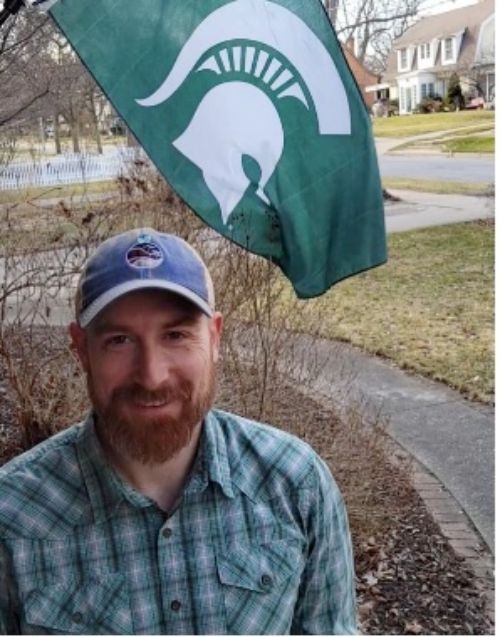Alumni Matt Bromley awarded NCSS Scientist of the Year
The USDA Natural Resource Conservation Service 'Soil and Plant Science Division' created the awards in 1999 to recognize scientists involved in the Soil Survey Program.

Matt Bromley: MLRA Soil Survey Leader / NESSR DSP POC
Soil and Plant Science Division | Northeast Soil Survey Region
Grand Rapids and Flint MLRA Soil Survey Offices
Matt graduated from our department "back when we had the old Environmental Soil Science degree, as one of the very few people to earn that degree while it was offered," PSM's Barret Wessel said. Matt now works in Grand Rapids in the Soil Survey Office "and still provides support to students and projects in our department."
Originally from Owosso, MI, Matt put a lot of effort into his experience at MSU, and got a lot out of it. "Dr. Delbert Mokma (retired) stood out to me when I was a student. I learned a lot from the courses he taught. I began my summer internship experience with NRCS having only taken an Intro to Soils course. After my first summer with NRCS and I returned to school, it was extremely helpful to have such a knowledgeable teacher helping me link the practical experience with the academic. I worked in the old Plant and Soil Test Lab for a couple semesters and getting to learn from Jon Dahl (retired) and the other staff in the lab. The key experience that really influenced how I’ve spent my career in soils was the career fair I attended at the Kellogg Center. I had only a vague idea that I wanted to do something with natural resources when I learned about NRCS and the career path of a soil scientist and mapper. I’m extremely thankful I went to that event!"
From the NCSS newsletter:
After learning about NRCS at a career fair during my junior year at Michigan State University, I accepted a position as a student trainee soil scientist in Marquette, MI. Two summers spent learning how to describe and map soils in neighboring Alger County solidified my desire to pursue a career in soils after graduation. In 2001, I started working full-time on the initial survey of Alger County and fell in love with the rewarding challenge of mapping the highly variable glacial deposits found in Michigan’s Upper Peninsula. Days spent mapping along the shores of Lake Superior in Pictured Rocks National Lakeshore certainly helped seal the deal. After completing Alger County, I was relocated to assist with the completion of the initial survey of Schoolcraft County. During this time, I also had the opportunity to complete short mapping details to Isle Royale National Park.
Along the way, I learned so much from the experienced soil mappers who supervised me including Larry Carey, Chuck Schwenner, Joe Calus, and Greg Whitney. My next move in 2006 was to the recently established Grand Rapids, MI MLRA Soil Survey Office where I took a position as a Soil Scientist-GIS Specialist. With the initial survey of Michigan nearly complete, our focus turned to updating existing soils information. However, before the state was officially completed, I was able to experience short details to assist with the mapping of the Detroit Metro Area. In 2011, I became the MLRA Soil Survey Leader in Grand Rapids. This shift along with the responsibilities of managing an office and supervising staff came with an adjustment period, but I enjoyed the new challenges. Over the years I’ve felt very lucky to have supervised several bright and talented younger soil scientists as they begin their careers.
Around this time, the MLRA office staff in the state received additional training on wetland determination and we began assisting the NRCS Michigan State Office with the high workload related to wetland compliance required for USDA program. This work continues to be a major component of our annual workload. I also enjoyed opportunities to complete short details over three years to assist with the initial mapping of White Mountains National Forest in New Hampshire. Recently I’ve been reinvigorated by working with Francine Lheritier and her great team as the Soil and Plant Science Division establishes standards and procedures to characterize dynamic soil properties. Providing information on changes in soil properties based on changes in ecological states and communities is another exciting way to improve the data available to users of soil survey.



 Print
Print Email
Email




